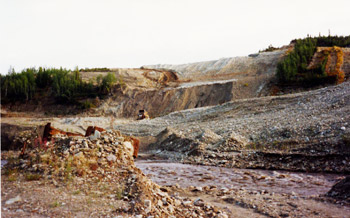Finaliste : Dan Gallacher, Dawson City

Faites défiler la liste vers le bas pour voir le diaporama des images de notre gagnante et des finalistes en plus de celles de quelques participants au concours.
Klondike Odyssey
Three artifacts deep in the Canadian Museum of Civilization’s collections storage spurred me in the early '90s on to a search for their place of origin, upwards of 5,000 kilometers distant.
Almost a century earlier the goldminer’s pan, shovel, and rocker box portrayed here were put to work at Poverty Bar on Bonanza Creek, in the Klondike River basin close-by Dawson City, Yukon, a present-day National Historic Site. I was very eager to walk on that sandbar, having earlier examined old-time goldfields on the Lower Fraser, the Kootenays, and in the Cariboo. Was the land largely unchanged, or dramatically altered by surface mining as it had been in various southern and central parts of British Columbia?
Each step of my new journey west, then north, took me further back in time. It began in a modern jetliner from Ottawa to Vancouver, followed by 1960s-70s turboprop aircraft to Whitehorse where I switched to a 1930s vintage DC3 departing for Dawson City that ultimately landed on a gravel strip runway. On letdown to the airport, I saw an unusual set of very long barren mounds set almost parallel to the Yukon River miles away. What were they?
Upon landing, I was taken by Parks Canada historians to the town and eventually driven to a location of sharp rises of gravel and sand, the structures I had seen from above. They earmarked a vastly altered waterway, a completely new terrain. Here was the Klondike River, not as it had been in the 1890s when the Museum’s pan, shovel, or rocker box had been in action, but very different now during the latest phase of Yukon goldmining.
The historians then told me that the initial placer mining through hand panning was soon replaced by sinking shafts into creekside permafrost, and once all the gold that could be extracted in that way was done, the miners built miles of wooden sluices to gravity-feed mountain waters into hoses and nozzles that in turn blasted the river banks away to reveal yet more traces of gold. They called it “hydraulicing”. Eventually newcomers constructed on-site massive floating wooden and iron giants to dredge creek and river bottoms, discarding tons and tons of sand and gravel overburden to locate even deeper gold deposits, thus creating the rows seen from above.
Today there are diesel-driven front-end loaders and dumptrucks working along the Klondike benches, still finding enough yellow mineral traces to make good profits. By my count this was the fifth major goldmining technique undertaken over time. Dawson City and the Klondike still is a superficial extractive frontier. And despite the repeated advances in labour-saving methods, neither the goal of its participants nor the nature of their work has altered much in over a century.
As in all of our National Historic Parks, there is much highly worthwhile to see and do. Few are as remote as Dawson, Yukon, however, and you cannot beat going there for first-hand observation or experience of a living past.